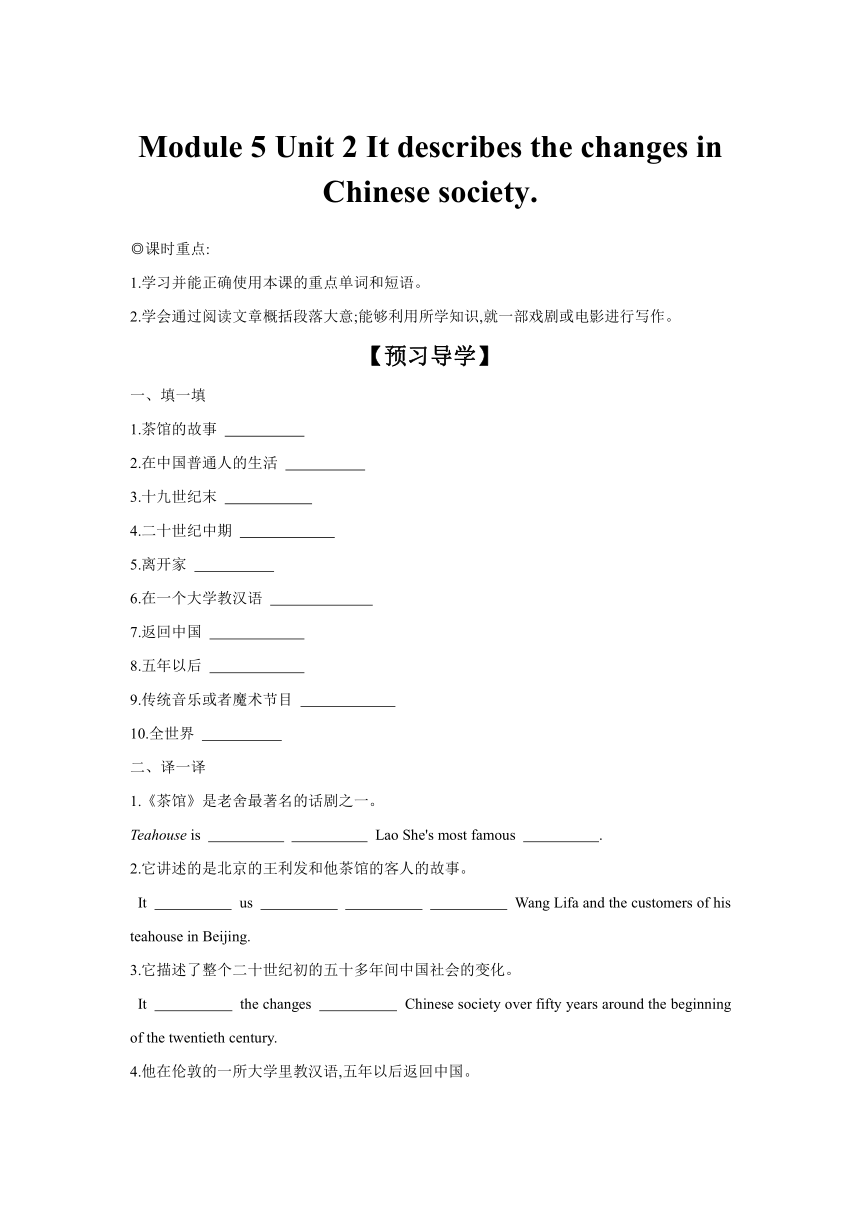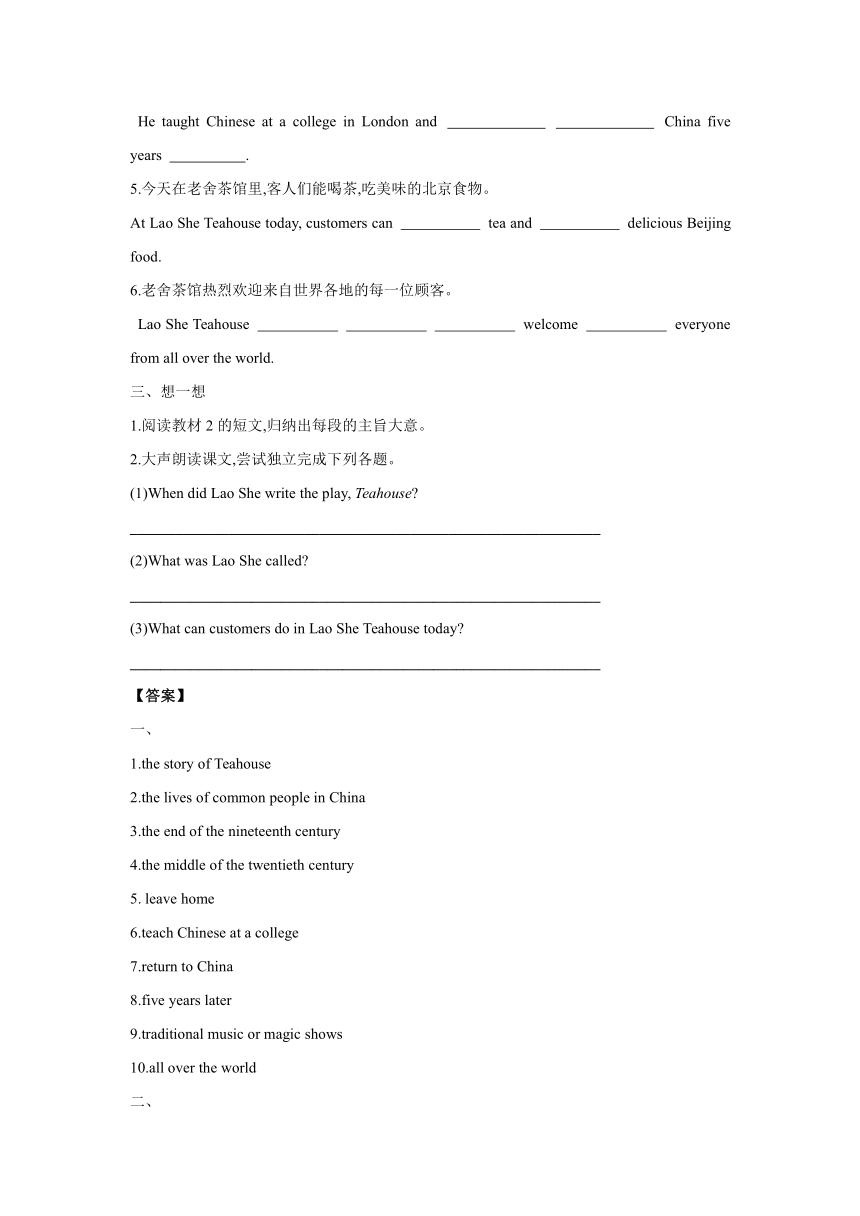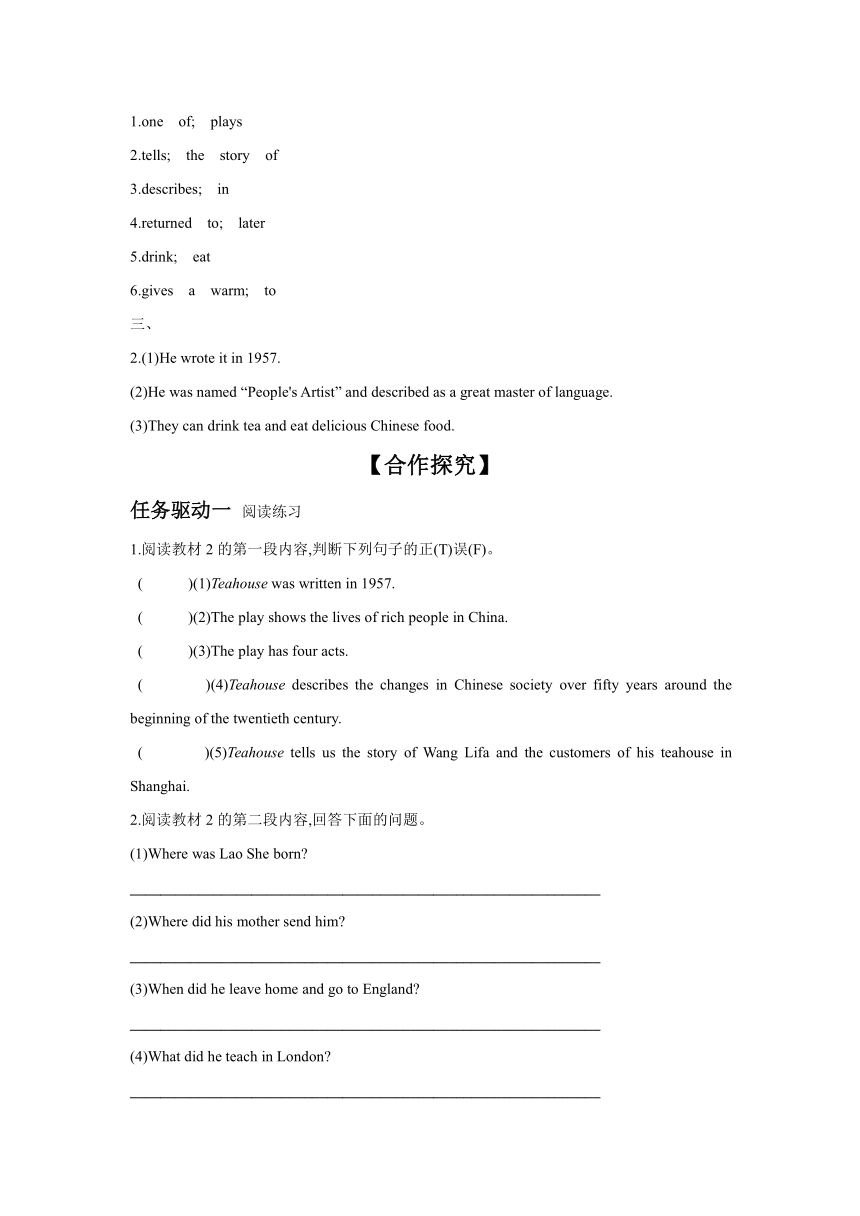Module 5 Unit 2 It describes the changes in Chinese society. 学案初中英语外研版八年级上册(含答案)
文档属性
| 名称 | Module 5 Unit 2 It describes the changes in Chinese society. 学案初中英语外研版八年级上册(含答案) |  | |
| 格式 | docx | ||
| 文件大小 | 20.4KB | ||
| 资源类型 | 教案 | ||
| 版本资源 | 外研版 | ||
| 科目 | 英语 | ||
| 更新时间 | 2024-02-28 06:59:35 | ||
图片预览



文档简介
Module 5 Unit 2 It describes the changes in Chinese society.
◎课时重点:
1.学习并能正确使用本课的重点单词和短语。
2.学会通过阅读文章概括段落大意;能够利用所学知识,就一部戏剧或电影进行写作。
【预习导学】
一、填一填
1.茶馆的故事
2.在中国普通人的生活
3.十九世纪末
4.二十世纪中期
5.离开家
6.在一个大学教汉语
7.返回中国
8.五年以后
9.传统音乐或者魔术节目
10.全世界
二、译一译
1.《茶馆》是老舍最著名的话剧之一。
Teahouse is Lao She's most famous .
2.它讲述的是北京的王利发和他茶馆的客人的故事。
It us Wang Lifa and the customers of his teahouse in Beijing.
3.它描述了整个二十世纪初的五十多年间中国社会的变化。
It the changes Chinese society over fifty years around the beginning of the twentieth century.
4.他在伦敦的一所大学里教汉语,五年以后返回中国。
He taught Chinese at a college in London and China five years .
5.今天在老舍茶馆里,客人们能喝茶,吃美味的北京食物。
At Lao She Teahouse today, customers can tea and delicious Beijing food.
6.老舍茶馆热烈欢迎来自世界各地的每一位顾客。
Lao She Teahouse welcome everyone from all over the world.
三、想一想
1.阅读教材2的短文,归纳出每段的主旨大意。
2.大声朗读课文,尝试独立完成下列各题。
(1)When did Lao She write the play, Teahouse
______________________________________________________________
(2)What was Lao She called
______________________________________________________________
(3)What can customers do in Lao She Teahouse today
______________________________________________________________
【答案】
一、
1.the story of Teahouse
2.the lives of common people in China
3.the end of the nineteenth century
4.the middle of the twentieth century
5. leave home
6.teach Chinese at a college
7.return to China
8.five years later
9.traditional music or magic shows
10.all over the world
二、
1.one of; plays
2.tells; the story of
3.describes; in
4.returned to; later
5.drink; eat
6.gives a warm; to
三、
2.(1)He wrote it in 1957.
(2)He was named “People's Artist” and described as a great master of language.
(3)They can drink tea and eat delicious Chinese food.
【合作探究】
任务驱动一 阅读练习
1.阅读教材2的第一段内容,判断下列句子的正(T)误(F)。
( )(1)Teahouse was written in 1957.
( )(2)The play shows the lives of rich people in China.
( )(3)The play has four acts.
( )(4)Teahouse describes the changes in Chinese society over fifty years around the beginning of the twentieth century.
( )(5)Teahouse tells us the story of Wang Lifa and the customers of his teahouse in Shanghai.
2.阅读教材2的第二段内容,回答下面的问题。
(1)Where was Lao She born
______________________________________________________________
(2)Where did his mother send him
______________________________________________________________
(3)When did he leave home and go to England
______________________________________________________________
(4)What did he teach in London
______________________________________________________________
(5)When did he return to China
______________________________________________________________
3.阅读教材2的第三段内容,完成下面的句子。
(1)Customers can and eat delicious Beijing food at Lao She Teahouse.
(2)We can enjoy the Beijing Opera, traditional music or magic shows in the .
(3)Lao She Teahouse welcome to everyone from all over the world.
任务驱动二 结对练习
1.完成教材3的表格。然后两人一组,就表格信息进行问答练习。
完成任务所需的语言结构:
A:When was Lao She Teahouse written
B:In 1957.
A:...
2.根据教材2的内容,进行对话练习。
完成任务所需的语言结构:
A:When did Lao She write Teahouse
B:He wrote it in ...
A:How many acts does the play have
B:It has ...
A:What does it describe
B:It describes the changes in Chinese society.
A:When did Lao She born
B:He was born in ...
3.阅读教材4,用方框中所给单词的适当形式填空,小组内核对答案。然后进行朗读练习,并回答下面的问题。
(1)What does Teahouse describe
______________________________________________________________
(2)When does the story happen
______________________________________________________________
(3)What did Lao She do in London
______________________________________________________________
任务驱动三 写作练习
1.认真观察教材5的表格,根据问题完成表格。 教师将全班同学分为A、B两个小组,以小组的形式就表格内容进行问答练习。
Group A:
(1)Where does the story take place
(2)When does the story take place
(3)What's the story's main idea
(4)Why is it good
Group B:
a.It takes place in Beijing.
b.From the end of the 19th century to the middle of the 20th century.
c.It tells us the story of Wang Lifa and the customers of his teahouse in Beijing.
d.Because it describes the changes in Chinese society.
2.写一篇短文介绍你最喜欢的话剧或电影,并把你写的短文读给全班同学听,选出最佳作品。
【答案】
任务驱动一
1.(1)T (2)F (3)F (4)T (5)F
2.(1)He was born in Beijing.
(2)A teacher's school.
(3)In 1924.
(4)He taught Chinese at a college.
(5)1929.
3.(1)drink tea (2)teahouse (3)gives a warm
任务驱动二
3.(1)It describes the story of Wang Lifa and the changes to the lives of common people in Chinese society.
(2)Over fifty years around the beginning of the twentieth century.
(3)He taught Chinese in London.
【知识超市】
●He taught Chinese at a college in London and returned to China five years later. 他在伦敦的一所大学里教汉语,五年以后返回中国。
1.teach Chinese意为“ 教汉语”,teach sb. to do sth.意为 “教某人去做某事”。例如:
She teaches us to play the piano on Sunday.
2.return to China意为“返回中国”。return to +地点,意为“返回某地”,等于get back to +地点。 return 还具有“归还”的意思。return sth. to sb.意为“把某物归还给某人”。例如:
We'll return to school in September.
I returned the book to him.
3.five years later 意为“五年以后”, 时间段+later, 意为“……以后”; in和after 也可意为“在……以后”,in 表示从现在算起到若干时间以后,常用于一般将来时和过去将来时。after 表示从过去算起到若干时间以后,常用于一般过去时。in 和after都要放在时间段之前。例如:
He'll come back in a week.
He came back after a few days.
He came back five days later.
做一做:单项选择。
( )1.I want to teach him English.
A.learn B.to learn
C.learning D.learns
( )2.My father returned home two years .
A.to; after B.to; later
C.不填; later D.to; in
【答案】
1~2 BB
●If you like the Beijing Opera, traditional music or magic shows, you can enjoy them at the teahouse. 如果你喜欢京剧、传统音乐或魔术表演,你可以在茶馆里欣赏它们。
if意为“如果” ,引导条件状语从句。需要注意的是:如果主句是将来时或祈使句,从句常用一般现在时表示将来的意思。
做一做:单项选择。
( )1.We will go for a picnic if it tomorrow.
A.doesn't rain B.wasn't rainy
C.won't rain D.wasn't raining
( )2.If Betty has time, she climbing with her parents tomorrow.
A.goes B.will go
C.doesn't go D.go
【答案】
1~2 AB
◎课时重点:
1.学习并能正确使用本课的重点单词和短语。
2.学会通过阅读文章概括段落大意;能够利用所学知识,就一部戏剧或电影进行写作。
【预习导学】
一、填一填
1.茶馆的故事
2.在中国普通人的生活
3.十九世纪末
4.二十世纪中期
5.离开家
6.在一个大学教汉语
7.返回中国
8.五年以后
9.传统音乐或者魔术节目
10.全世界
二、译一译
1.《茶馆》是老舍最著名的话剧之一。
Teahouse is Lao She's most famous .
2.它讲述的是北京的王利发和他茶馆的客人的故事。
It us Wang Lifa and the customers of his teahouse in Beijing.
3.它描述了整个二十世纪初的五十多年间中国社会的变化。
It the changes Chinese society over fifty years around the beginning of the twentieth century.
4.他在伦敦的一所大学里教汉语,五年以后返回中国。
He taught Chinese at a college in London and China five years .
5.今天在老舍茶馆里,客人们能喝茶,吃美味的北京食物。
At Lao She Teahouse today, customers can tea and delicious Beijing food.
6.老舍茶馆热烈欢迎来自世界各地的每一位顾客。
Lao She Teahouse welcome everyone from all over the world.
三、想一想
1.阅读教材2的短文,归纳出每段的主旨大意。
2.大声朗读课文,尝试独立完成下列各题。
(1)When did Lao She write the play, Teahouse
______________________________________________________________
(2)What was Lao She called
______________________________________________________________
(3)What can customers do in Lao She Teahouse today
______________________________________________________________
【答案】
一、
1.the story of Teahouse
2.the lives of common people in China
3.the end of the nineteenth century
4.the middle of the twentieth century
5. leave home
6.teach Chinese at a college
7.return to China
8.five years later
9.traditional music or magic shows
10.all over the world
二、
1.one of; plays
2.tells; the story of
3.describes; in
4.returned to; later
5.drink; eat
6.gives a warm; to
三、
2.(1)He wrote it in 1957.
(2)He was named “People's Artist” and described as a great master of language.
(3)They can drink tea and eat delicious Chinese food.
【合作探究】
任务驱动一 阅读练习
1.阅读教材2的第一段内容,判断下列句子的正(T)误(F)。
( )(1)Teahouse was written in 1957.
( )(2)The play shows the lives of rich people in China.
( )(3)The play has four acts.
( )(4)Teahouse describes the changes in Chinese society over fifty years around the beginning of the twentieth century.
( )(5)Teahouse tells us the story of Wang Lifa and the customers of his teahouse in Shanghai.
2.阅读教材2的第二段内容,回答下面的问题。
(1)Where was Lao She born
______________________________________________________________
(2)Where did his mother send him
______________________________________________________________
(3)When did he leave home and go to England
______________________________________________________________
(4)What did he teach in London
______________________________________________________________
(5)When did he return to China
______________________________________________________________
3.阅读教材2的第三段内容,完成下面的句子。
(1)Customers can and eat delicious Beijing food at Lao She Teahouse.
(2)We can enjoy the Beijing Opera, traditional music or magic shows in the .
(3)Lao She Teahouse welcome to everyone from all over the world.
任务驱动二 结对练习
1.完成教材3的表格。然后两人一组,就表格信息进行问答练习。
完成任务所需的语言结构:
A:When was Lao She Teahouse written
B:In 1957.
A:...
2.根据教材2的内容,进行对话练习。
完成任务所需的语言结构:
A:When did Lao She write Teahouse
B:He wrote it in ...
A:How many acts does the play have
B:It has ...
A:What does it describe
B:It describes the changes in Chinese society.
A:When did Lao She born
B:He was born in ...
3.阅读教材4,用方框中所给单词的适当形式填空,小组内核对答案。然后进行朗读练习,并回答下面的问题。
(1)What does Teahouse describe
______________________________________________________________
(2)When does the story happen
______________________________________________________________
(3)What did Lao She do in London
______________________________________________________________
任务驱动三 写作练习
1.认真观察教材5的表格,根据问题完成表格。 教师将全班同学分为A、B两个小组,以小组的形式就表格内容进行问答练习。
Group A:
(1)Where does the story take place
(2)When does the story take place
(3)What's the story's main idea
(4)Why is it good
Group B:
a.It takes place in Beijing.
b.From the end of the 19th century to the middle of the 20th century.
c.It tells us the story of Wang Lifa and the customers of his teahouse in Beijing.
d.Because it describes the changes in Chinese society.
2.写一篇短文介绍你最喜欢的话剧或电影,并把你写的短文读给全班同学听,选出最佳作品。
【答案】
任务驱动一
1.(1)T (2)F (3)F (4)T (5)F
2.(1)He was born in Beijing.
(2)A teacher's school.
(3)In 1924.
(4)He taught Chinese at a college.
(5)1929.
3.(1)drink tea (2)teahouse (3)gives a warm
任务驱动二
3.(1)It describes the story of Wang Lifa and the changes to the lives of common people in Chinese society.
(2)Over fifty years around the beginning of the twentieth century.
(3)He taught Chinese in London.
【知识超市】
●He taught Chinese at a college in London and returned to China five years later. 他在伦敦的一所大学里教汉语,五年以后返回中国。
1.teach Chinese意为“ 教汉语”,teach sb. to do sth.意为 “教某人去做某事”。例如:
She teaches us to play the piano on Sunday.
2.return to China意为“返回中国”。return to +地点,意为“返回某地”,等于get back to +地点。 return 还具有“归还”的意思。return sth. to sb.意为“把某物归还给某人”。例如:
We'll return to school in September.
I returned the book to him.
3.five years later 意为“五年以后”, 时间段+later, 意为“……以后”; in和after 也可意为“在……以后”,in 表示从现在算起到若干时间以后,常用于一般将来时和过去将来时。after 表示从过去算起到若干时间以后,常用于一般过去时。in 和after都要放在时间段之前。例如:
He'll come back in a week.
He came back after a few days.
He came back five days later.
做一做:单项选择。
( )1.I want to teach him English.
A.learn B.to learn
C.learning D.learns
( )2.My father returned home two years .
A.to; after B.to; later
C.不填; later D.to; in
【答案】
1~2 BB
●If you like the Beijing Opera, traditional music or magic shows, you can enjoy them at the teahouse. 如果你喜欢京剧、传统音乐或魔术表演,你可以在茶馆里欣赏它们。
if意为“如果” ,引导条件状语从句。需要注意的是:如果主句是将来时或祈使句,从句常用一般现在时表示将来的意思。
做一做:单项选择。
( )1.We will go for a picnic if it tomorrow.
A.doesn't rain B.wasn't rainy
C.won't rain D.wasn't raining
( )2.If Betty has time, she climbing with her parents tomorrow.
A.goes B.will go
C.doesn't go D.go
【答案】
1~2 AB
同课章节目录
- Module 1 How to learn English
- Unit 1 Let's try to speak English as much as possi
- Unit 2 You should smile at her.
- Unit 3 Language in use .
- Module 2 My home town and my country
- Unit 1 It's taller than many other buildings.
- Unit 2 Cambridge is a beautiful city in the east o
- Unit 3 Language in use .
- Module 3 Sports.
- Unit 1 Nothing is more exciting than playing tenni
- Unit 2 This year we training more carefully.
- Unit 3 Language in use .
- Module 4 Planes, ships and trains .
- Unit 1 He lives the farthest from school.
- Unit 2 What is the best way to travel.
- Unit 3 Language in use .
- Module 5 Lao She Teahouse.
- Unit 1 I wanted to see the Beijing Opera.
- Unit 2 It descibes the changes in Chinese society.
- Unit 3 Language in use .
- Module 6 Animals in danger.
- Unit 1 It allows people to get closer to them .
- Unit 2 The WWF is working hard to save them all.
- Unit 3 Language in use .
- Revision module A
- Module 7 A famous story
- Unit 1 Alice was sitting with her sister by the ri
- Unit 2 She was thinking about her cat.
- Unit 3 Language in use .
- Module 8 Accidents
- Unit 1 While the car were changing to red, a car s
- Unit 2 I was trying to pick it up when it bite me
- Unit 3 Language in use .
- Module 9 Population
- Unit 1 The population of China is about 1.37 billi
- Unit 2 Arnwick was a city with 200,000 people.
- Unit 3 Language in use .
- Module 10 The weathe
- Unit 1 It might snow.
- Unit 2 The weather is fine all year round.
- Unit 3 Language in use .
- Module 11 Way of life
- Unit 1 In China ,we open a gift later.
- Unit 2 In England, you usually drink tea with milk
- Unit 3 Language in use .
- Module 12 Help
- Unit 1 What should we do before help arrives?
- Unit 2 Stay away from windows and heavy furniture.
- Unit 3 Language in use .
- Revision module B
